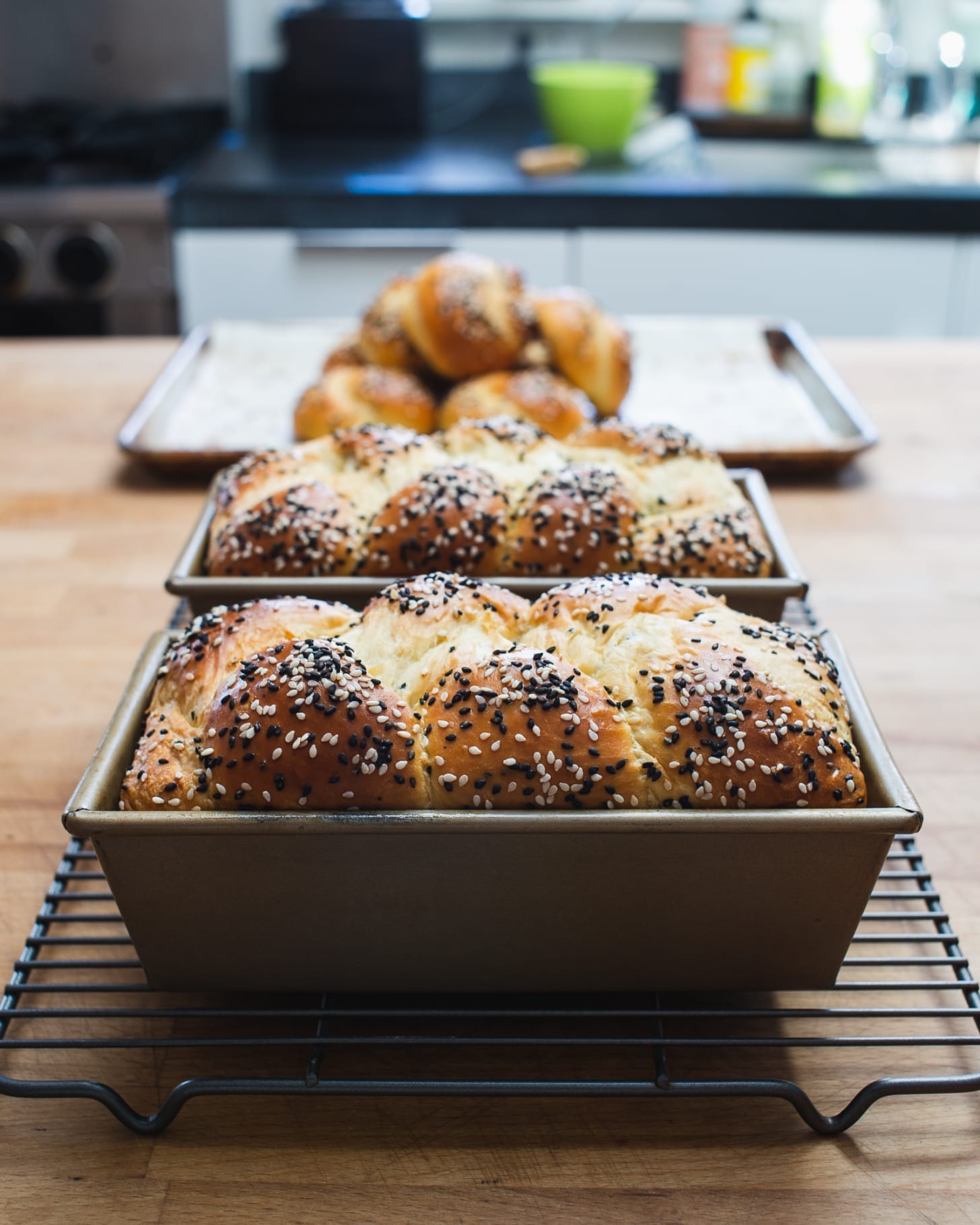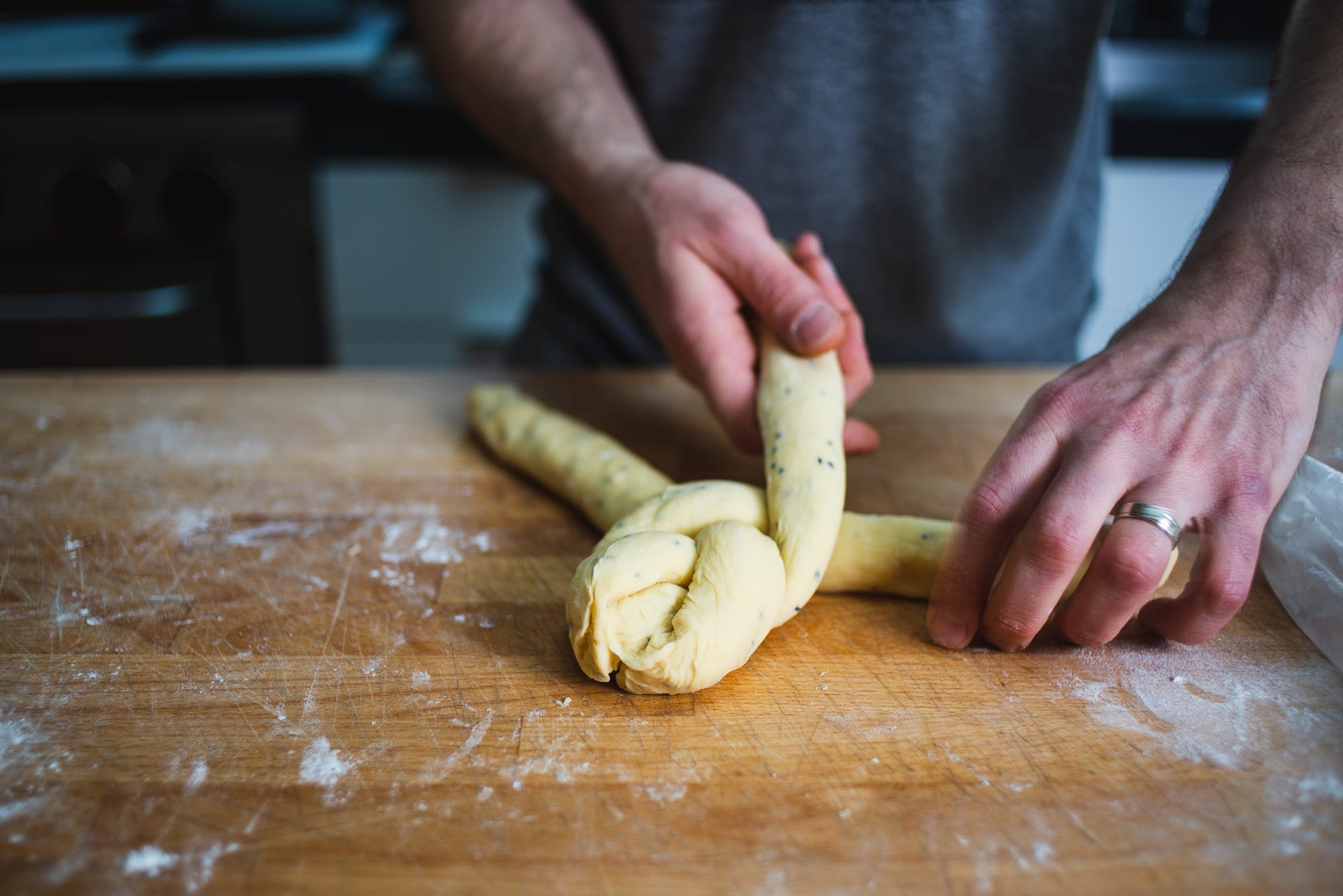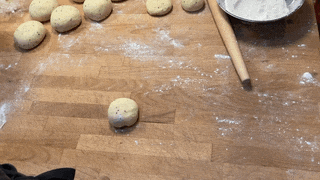Recipe: Tangzhong Choreg
aka Armenian Easter Bread

Table of Contents
This week’s recipe—choreg, an Armenian favorite—is coming a few days early, because I am doing a free online demo about it for Oldways and the Armenian Heritage Park in Boston on Wednesday at 10AM EST. It’s only an hour long, so I won’t really get to show much in the way of process, but I’ll cover what makes this bread so special, and what’s different about my own recipe. (And yes, those of you who have been here since the early days will recognize that I posted a version of this recipe back in April. The formula has been refined a little since then, and I’ve filled in some of the details in the intro.)
Choreg is made throughout the Xtian Levant, but Armos are absolutely obsessed with it. And though it is known as an Easter bread, eaten to celebrate the end of the Lenten fast—it is loaded with butter, eggs and sugar, perfect for indulging after a long period of abstinence—we make it year round, particularly in roll form. My version is super plush and long-keeping, thanks to the addition of a tangzhong flour paste, a bread making technique that comes from China and Japan. You’ll hear more about the tangzhong technique again, since I’m enamored of it and use it wherever appropriate (this brioche uses one as well), but the basic idea is this:
You start by heating a small portion of the flour and water from the dough until the starches in the flour gel, forming a thick, pudding-like paste. Once cooled, the paste is incorporated into the final dough. Because the water in the paste is bound up within the starches, it adds moisture to the dough without making the dough wetter.
In other words, using a tangzhong paste can increase the hydration of a bread, without turning the dough into a sticky mess. That extra “hidden” water makes the loaf softer and also slower to stale. (The latter effect is particularly helpful in high-sugar breads like choreg, which can turn stale really fast.)
A few other things about choreg that distinguish it from other similar enriched breads like brioche, challah, pain de mie, etc.:
1) It has a ton of sugar, 26% in this case. That’s why I call for osmotolerant yeast, which is a type of yeast that is bred to do well in the presence of so much sugar, which can cause other types of yeast to die, requiring a much larger amount than you’d normally use. Sugar, like salt, holds onto water strongly (i.e., it is hygroscopic), which means there is less water available for the yeast.
All that sugar is also why most choreg go stale so quickly, since the sugar pulls the water out of the starches, forcing them to crystallize. (Staling—also known as retrogradation—is not really about bread “drying out”, it is rather the soft-when-freshly-baked starches in the loaf firming up as they crystallize.) Which is why using a tangzhong is especially helpful here.
2) Choreg is flavored with two spices, nigella and mahlab.

Nigella (left) are the tiny black seeds of Nigella sativa, a plant native to and a spice used throughout the Middle East, North Africa, and South Asia. Nigella has an earthy, bitter flavor and aroma that is hard to pin down, but it is often compared to onion, oregano, or cumin. In the Levant it is used as a topping or flavoring for breads and other baked goods. Armenians also use it to flavor string cheese. And in eastern India (Bengal), Bangladesh, and Nepal, nigella is one element of panch phoran, or "Indian five-spice", a combination of whole fenugreek seed, nigella seed, cumin seed, black mustard seed and fennel seed. Nigella seeds are almost always used whole, because they are more intensely bitter when ground.
Mahlab (right) are the kernels of a cherry, Prunus mahaleb. They are used throughout the Middle East to lend their subtle cherry/bitter almond aroma to breads, pastries, and sweets. The hard seeds are always ground before use. They are high in oil, quick to turn rancid, and somewhat expensive, so they are best stored in the freezer in an airtight container.
I sent this recipe to an Armenian friend who owns a flour milling operation and bakery in Beirut, Lebanon (which seems to be doing okay after the massive explosions there last month, thankfully) and they made beautiful versions of it in pullman pans (one full recipe per 13-inch pan, I believe).
Please let me know if you have questions about it, and let me know if you make it. And if you like it, please share this post with others!
- Andrew

Tangzhong Choreg (Armenian Easter Bread)
Dough Yield: 1150 grams
Yield: two 575g pan loaves or twelve 95g rolls
Notes: Osmotolerant yeast—such as SAF Gold—is bred to thrive in high-sugar environments like this one; if using instant yeast, increase the amount to 2.25% (11g). I use nonfat milk powder out of convenience because I don’t keep milk in the fridge, but milk can be used in place of the water and milk powder in steps 2 and 3. Nigella seed and mahlab (sour cherry seed kernels) are available in Middle Eastern grocery stores (nigella can also be found in South Asian markets, where it’s called kalonji) or online; if unavailable they can be left out, but they are what make choreg distinctive. The mahlab should be ground to a fine powder in a spice mill before use. The dough is quite sticky, particularly before refrigerating; it’s relatively easy to shape when cold. When shaping dough, flour hands, countertop, and exterior of dough well, but try not to overdo it. If you don’t yet have a pocket gram scale for the <10g weights listed, consult my conversion chart. (I’ve given teaspoon amounts for ingredients that aren’t on that list.)
Overall Formula/Baker’s Percentages:
bread flour 100%
water 44%
unsalted butter 24%
sugar 26%
eggs 31%
nonfat milk powder 5%
osmotolerant yeast 1.5%
nigella seed 1.0%
ground mahlab 1.0%
salt 2%
Tangzhong Flour Paste:
50g bread flour
215g water
Final Dough:
115g unsalted butter, cubed, cold (1 stick)
125g sugar
150g eggs (3 large)
440g bread flour
25g nonfat milk powder
7g osmotolerant yeast (1-3/4 teaspoons) or 11g instant yeast (2-1/8 teaspoons)
5g nigella seed (1-1/2 teaspoons)
5g ground mahlab (1-1/2 teaspoons)
10g salt (2 teaspoons table)
sesame seeds (for topping, about 2 tablespoons)
1. FOR TANGZHONG FLOUR PASTE: Whisk flour and water together in small saucepan until smooth. Heat over medium heat, whisking constantly, until thickened and glossy, about 5 minutes. (Alternatively, place in bowl, cover loosely and microwave in 30 second intervals until thickened and glossy.) Transfer to bowl of stand mixer.
2. FOR CHOREG DOUGH: Add butter a few pieces at a time to flour paste and whisk until butter is melted and mixture is fully combined. Add sugar and eggs and whisk until fully combined. Allow to cool to room temperature, 5 to 10 minutes.
3. Add flour, milk powder, yeast, nigella, and mahlab to bowl and, using dough hook, mix on low until uniform and no dry flour remains. Cover loosely and let stand for 30 minutes.
4. Add salt and mix on medium speed until dough starts to clear sides and bottom of bowl (it will remain webby and sticky), 10 to 12 minutes.
5. Desired Dough Temperature: 75°F.
6. Proof at room temperature for 90 minutes, covered, with two folds at 30 and 60 minutes. [Pro tip: just leave the dough in the stand mixer, covered with a towel, and run it on low for 5 seconds to perform each “fold”.]
7. Transfer to medium bowl and cover tightly and refrigerate for 12 to 18 hours.
8. FOR PAN OR FREEFORM LOAVES: Grease two 8.5-inch by 4.5-inch loaf pans. For freeform loaves, line a baking sheet with parchment. Divide dough into six 190g portions. Round tightly and rest, covered, for 30 minutes.
9. Pat and stretch each round into oval. Fold long edges of oval toward center to form rectangle. Fold in half along long axis to form log and seal. Using hands, roll log from center into 12-inch long rope. Repeat with remaining dough balls. Braid 3 strands and transfer to pan, folding ends of strands under loaf.

10. Cover loaves loosely with plastic wrap and allow to rise at room temperature until almost doubled in size (dough should rise to about top edge of pan), 1 ½ to 2 hours. Thirty minutes before baking, adjust oven rack to middle position, place baking stone on rack, and heat oven to 325 degrees.
11. Brush loaves gently with egg wash (1 egg/1 teaspoon water/pinch salt) and sprinkle with sesame seeds. Bake until golden brown, 30 to 40 minutes, rotating pans halfway through baking. Transfer pans to wire rack and let cool for 5 minutes. Remove loaves from pan and allow to cool at least 2 hours before slicing.
8. FOR ROLLS: Line 2 baking sheets with parchment. Divide dough into twelve 95g pieces. Round tightly and rest, covered, for 30 minutes.
9. Pat and stretch each round into oval. Fold long edges of oval toward center to form rectangle. Fold in half along long axis to form log and seal. Using hands, roll log from center into 6-inch long rope and form into twist. Transfer to pan and repeat with remaining dough balls.
10. Cover loosely with plastic wrap and allow to rise at room temperature until almost doubled in size, 1 ½ to 2 hours.
11. Brush rolls gently with egg wash and sprinkle with sesame seeds. Bake at 325 degrees for 18 to 23 minutes, rotating pans halfway through baking. Transfer pans to wire rack and let rolls cool at least 10 minutes before serving.
wordloaf Newsletter
Join the newsletter to receive the latest updates in your inbox.




